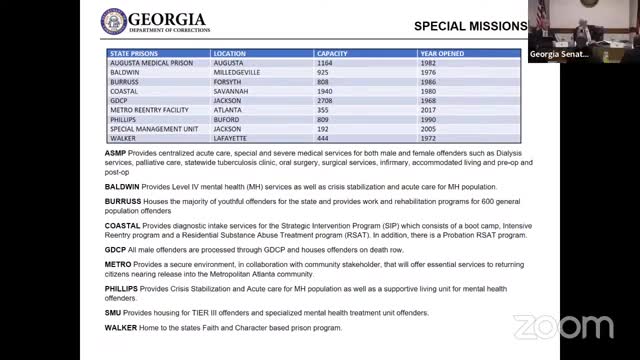Prisons Face Rising Challenges Amid Substance Abuse Crisis
August 24, 2024 | SENATE, Committees, Legislative, Georgia
This article was created by AI summarizing key points discussed. AI makes mistakes, so for full details and context, please refer to the video of the full meeting. Please report any errors so we can fix them. Report an error »

In a recent government meeting, officials discussed pressing issues surrounding substance abuse, gang violence, and prison infrastructure in Georgia. The conversation highlighted the need for comprehensive data collection on substance abuse trends, particularly focusing on the prevalence of methamphetamine and alcohol-related issues. Officials acknowledged the challenges in rehabilitation, suggesting that incarceration may sometimes be the most effective solution for severe addiction cases.
The meeting also addressed the growing problem of contraband in prisons, particularly the use of treated paper for drug consumption. Officials are exploring advanced scanning technology to detect such materials in incoming mail, aiming to curb this dangerous trend.
Gang violence was another significant topic, with reports indicating that up to 90% of violent crimes in Georgia are linked to criminal street gangs. Officials noted a concerning correlation between gang activity and the influx of contraband and cell phones within the prison system. The emergence of hybrid gangs, which consist of members from different gangs collaborating inside prisons, was also discussed.
Infrastructure challenges were a focal point, particularly regarding aging facilities like the Georgia Diagnostic and Classification Prison, which houses male death row inmates. While the facility has been maintained well, officials acknowledged the need for renovations to accommodate changing inmate populations and modern security requirements.
The meeting also highlighted the success of smaller, specialized facilities, such as the Metro Reentry Facility and Walker State Prison, which focus on rehabilitation through faith-based programs. These facilities have shown promising results in helping inmates reintegrate into society, with a strong emphasis on vocational training and mentorship.
As discussions continued, officials emphasized the importance of investing in new prison construction, advocating for single-man cells to reduce violence and improve inmate safety. The projected costs for new facilities were discussed, with estimates reaching up to $1.2 billion for comprehensive, secure environments.
Overall, the meeting underscored the complexities of managing substance abuse, gang violence, and prison infrastructure, while also highlighting successful rehabilitation programs that could serve as models for future initiatives.
The meeting also addressed the growing problem of contraband in prisons, particularly the use of treated paper for drug consumption. Officials are exploring advanced scanning technology to detect such materials in incoming mail, aiming to curb this dangerous trend.
Gang violence was another significant topic, with reports indicating that up to 90% of violent crimes in Georgia are linked to criminal street gangs. Officials noted a concerning correlation between gang activity and the influx of contraband and cell phones within the prison system. The emergence of hybrid gangs, which consist of members from different gangs collaborating inside prisons, was also discussed.
Infrastructure challenges were a focal point, particularly regarding aging facilities like the Georgia Diagnostic and Classification Prison, which houses male death row inmates. While the facility has been maintained well, officials acknowledged the need for renovations to accommodate changing inmate populations and modern security requirements.
The meeting also highlighted the success of smaller, specialized facilities, such as the Metro Reentry Facility and Walker State Prison, which focus on rehabilitation through faith-based programs. These facilities have shown promising results in helping inmates reintegrate into society, with a strong emphasis on vocational training and mentorship.
As discussions continued, officials emphasized the importance of investing in new prison construction, advocating for single-man cells to reduce violence and improve inmate safety. The projected costs for new facilities were discussed, with estimates reaching up to $1.2 billion for comprehensive, secure environments.
Overall, the meeting underscored the complexities of managing substance abuse, gang violence, and prison infrastructure, while also highlighting successful rehabilitation programs that could serve as models for future initiatives.
View full meeting
This article is based on a recent meeting—watch the full video and explore the complete transcript for deeper insights into the discussion.
View full meeting
